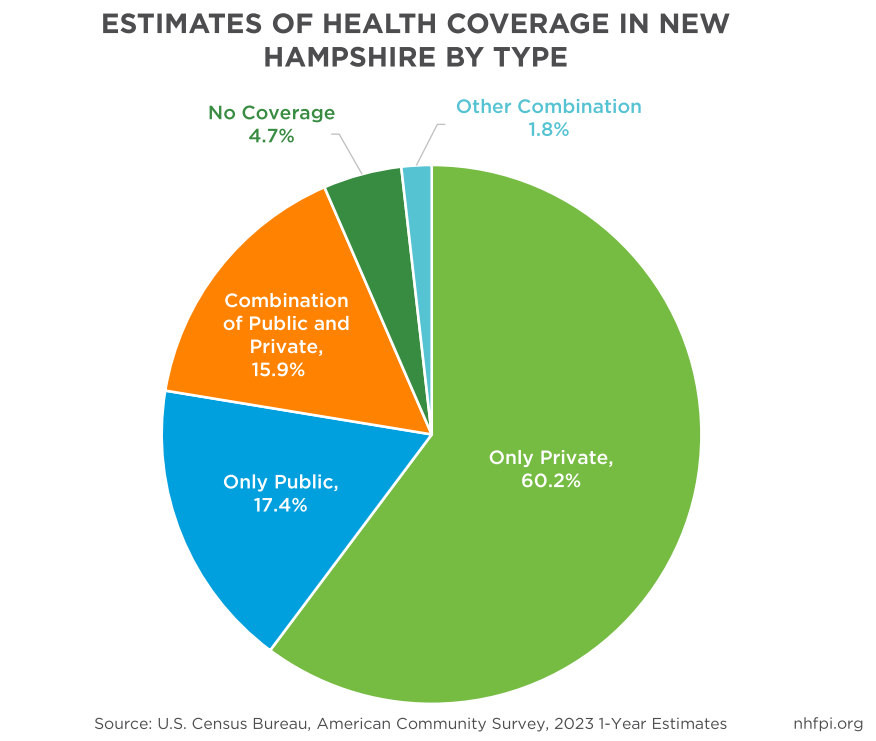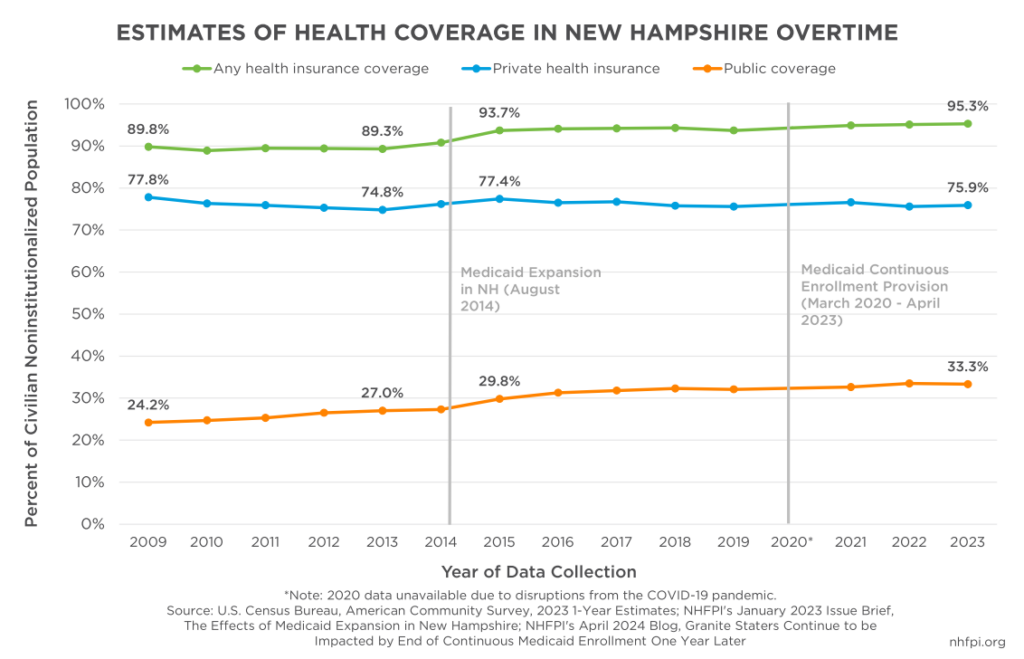Recent data released by the U.S. Census Bureau’s American Community Survey provides insight into health insurance coverage among New Hampshire residents. Approximately three in four Granite Staters were enrolled in private insurance in 2023, with most receiving coverage through an employer. About one in three New Hampshire residents relied on public insurance for part or all of their health coverage, and despite increased enrollment in Medicaid over the prior decade, about 4.7 percent of the state’s population remained uninsured in 2023.
Types of Coverage
In 2023, about 60.2 percent of Granite Staters were covered by private insurance only, including those who received coverage through their employer, purchased their insurance directly, or were beneficiaries of Tricare or another type of private military coverage. Employer-based coverage remained the largest type of health insurance coverage in the state, with more than half (52.8 percent) of the state’s population receiving coverage only through their employer.
Approximately 17.4 percent of the state’s residents received coverage only through public insurance in 2023, including through Medicaid, Medicare, or coverage under the Veterans’ Administration. An estimated 9.4 percent of the state was insured only through Medicaid, which provides coverage to Granite Staters with low incomes and those who have certain disabilities, as well as other eligible populations. A slightly smaller proportion of Granite Staters (about 7.8 percent) had only Medicare coverage, with all residents over the age of 65 typically qualifying for coverage under this program. About 15.9 percent of the state’s population was covered through a combination of both private and public insurance in 2023, which includes a significant number of older adults enrolled in Medicare and purchasing supplementary plans; in 2023, approximately 13.8 percent of the population had a combination of Medicare and another coverage plan.
Around 65,600 New Hampshire residents, or about 4.7 percent of the state, were uninsured in 2023, which was equivalent to about the 2023 population sizes of Keene, Portsmouth, Claremont, and Peterborough combined. While U.S. Census Bureau data scheduled to be released in December 2024 will provide more reliable insights, estimates show those who were uninsured had a greater likelihood of being between the ages of 18 and 45, having a lower educational attainment, and having a household income lower than 138 percent of the federal poverty guidelines, which is $34,306 for a family of three in 2023. Granite Staters who identified as Black or African American, Biracial or Multiracial, or Hispanic or Latino of any race were also more likely to be uninsured in 2023 compared to those identifying as white and non-Hispanic.
Coverage Gains and Future Challenges
In 2023, about 95.3 percent of the state’s population had insurance coverage, which was an increase of about 6.0 percentage points from 2013. While the proportion of residents with private insurance has remained relatively stable from 2013 to 2023, a 6.3 percentage point increase in public insurance coverage during this time reflects both federal– and state-level policy decisions. The passage of the federal Patient Protection and Affordable Care Act, and the subsequent 2014 Medicaid Expansion in New Hampshire, secured coverage for many who had not otherwise been able to afford health insurance or obtain insurance through their employer. As a result of these policies, the percentage of the state’s population who were uninsured declined by more than half, from about 10.7 percent who were uninsured in 2013 to 4.7 percent in 2023.
The percentage of state residents enrolled in public insurance coverage has also increased as a result of temporary pandemic-related policies impacting Medicaid enrollees. During the COVID-19 Public Health Emergency, the federal government permitted states to allow Medicaid beneficiaries to remain continuously enrolled in the program without having to regularly renew their coverage, in exchange for additional federal Medicaid funding. According to the New Hampshire Department of Health and Human Services (DHHS), enrollment in the Medicaid program grew by about 40.1 percent between March 2020 and March 2023, when enrollment reached a historic peak of 251,491 beneficiaries. Upon expiration of the federal continuous enrollment provision, on April 1, 2023 the State began disenrolling beneficiaries through a process known as the “unwind.” According to DHHS, the equivalent of slightly more than one in four (27.2 percent) individuals enrolled in Medicaid in March 2023 have lost Medicaid coverage as of September 30, 2024; 183,207 people were enrolled in the program according to the most recent DHHS caseload report. Although the number of enrollees has declined, the number of New Hampshire residents enrolled in the state’s Medicaid program remains higher than in 2019 prior to the pandemic.
In addition to policies impacting Medicaid, increases in the number of older adults have likely influenced higher rates of public insurance coverage compared to a decade ago. According to the U.S. Census Bureau’s Population Estimates Program, the percentage of the state’s population over the age of 65 increased by about 5.5 percentage points between 2013 and 2023. As of July 1, 2023, older adults comprised about 20.8 percent of New Hampshire’s population, and the New Hampshire Department of Business and Economic Affairs project this percentage will grow to about 26.9 percent by 2050. With the number of older adults in the state expected to continue to increase, more Granite Staters will likely be relying on public insurance through Medicare in the future. As the state navigates demographic shifts, ongoing efforts to support health care coverage will be crucial to helping ensure that residents have access to health services.
– Jessica Williams, Policy Analyst


